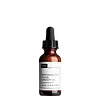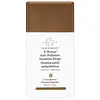What's inside
What's inside
 Key Ingredients
Key Ingredients

 Benefits
Benefits

 Concerns
Concerns

 Ingredients Side-by-side
Ingredients Side-by-side

Water
Skin ConditioningCaprylyl Methicone
Skin ConditioningTitanium Dioxide
Cosmetic ColorantIsodecyl Neopentanoate
EmollientMica
Cosmetic ColorantTrimethylsiloxysilicate
EmollientCetearyl Alcohol
EmollientPropanediol
SolventCaramel
Cosmetic ColorantCeteth-20 Phosphate
CleansingCI 77491
Cosmetic ColorantSodium Hyaluronate
HumectantPseudoalteromonas Exopolysaccharides
Skin ConditioningAllantoin
Skin ConditioningGlucose
HumectantFructose
HumectantMaltose
MaskingTrehalose
HumectantSodium Lactate
BufferingSodium PCA
HumectantUrea
BufferingPolypodium Vulgare Rhizome Extract
HumectantCetraria Islandica Thallus Extract
HumectantSphagnum Magellanicum Extract
Skin ConditioningPentylene Glycol
Skin ConditioningGlycerin
HumectantCarrageenan
Acacia Senegal Gum
MaskingMethyl Methacrylate/PEG/PPG-4/3 Methacrylate Crosspolymer
Dicetyl Phosphate
EmulsifyingSynthetic Fluorphlogopite
Tin Oxide
AbrasiveSodium Chloride
MaskingSodium Hydroxide
BufferingSodium Salicylate
PreservativeTriethanolamine
BufferingCitric Acid
BufferingPhenoxyethanol
PreservativeChlorphenesin
AntimicrobialWater, Caprylyl Methicone, Titanium Dioxide, Isodecyl Neopentanoate, Mica, Trimethylsiloxysilicate, Cetearyl Alcohol, Propanediol, Caramel, Ceteth-20 Phosphate, CI 77491, Sodium Hyaluronate, Pseudoalteromonas Exopolysaccharides, Allantoin, Glucose, Fructose, Maltose, Trehalose, Sodium Lactate, Sodium PCA, Urea, Polypodium Vulgare Rhizome Extract, Cetraria Islandica Thallus Extract, Sphagnum Magellanicum Extract, Pentylene Glycol, Glycerin, Carrageenan, Acacia Senegal Gum, Methyl Methacrylate/PEG/PPG-4/3 Methacrylate Crosspolymer, Dicetyl Phosphate, Synthetic Fluorphlogopite, Tin Oxide, Sodium Chloride, Sodium Hydroxide, Sodium Salicylate, Triethanolamine, Citric Acid, Phenoxyethanol, Chlorphenesin
Water
Skin ConditioningHydrogenated Polyisobutene
EmollientGlyceryl Oleate Citrate
EmulsifyingMica
Cosmetic ColorantHydroxyethyl Acrylate/Sodium Acryloyldimethyl Taurate Copolymer
Emulsion StabilisingGlycerin
HumectantRibes Nigrum Seed Oil
EmollientSclerocarya Birrea Seed Oil
HumectantTheobroma Cacao Extract
Skin ConditioningCaprylic/Capric Triglyceride
MaskingVitis Vinifera Seed Extract
AntimicrobialLecithin
EmollientAcetyl Tetrapeptide-17
Skin ConditioningLinoleic Acid
CleansingLinolenic Acid
CleansingSorbitan Isostearate
EmulsifyingCamellia Sinensis Leaf Extract
AntimicrobialMaltodextrin
AbsorbentSodium Hyaluronate Crosspolymer
HumectantMagnolia Officinalis Bark Extract
AntimicrobialGlutamylamidoethyl Imidazole
Colloidal Platinum
AntimicrobialTocopherol
AntioxidantPhenoxyethanol
PreservativePentylene Glycol
Skin ConditioningSodium Benzoate
MaskingSorbic Acid
PreservativeCaprylyl Glycol
EmollientBoron Nitride
AbsorbentHexylene Glycol
EmulsifyingPolysorbate 60
EmulsifyingEthylhexylglycerin
Skin ConditioningCI 77491
Cosmetic ColorantCI 77492
Cosmetic ColorantCI 77499
Cosmetic ColorantSodium C14-16 Olefin Sulfonate
CleansingWater, Hydrogenated Polyisobutene, Glyceryl Oleate Citrate, Mica, Hydroxyethyl Acrylate/Sodium Acryloyldimethyl Taurate Copolymer, Glycerin, Ribes Nigrum Seed Oil, Sclerocarya Birrea Seed Oil, Theobroma Cacao Extract, Caprylic/Capric Triglyceride, Vitis Vinifera Seed Extract, Lecithin, Acetyl Tetrapeptide-17, Linoleic Acid, Linolenic Acid, Sorbitan Isostearate, Camellia Sinensis Leaf Extract, Maltodextrin, Sodium Hyaluronate Crosspolymer, Magnolia Officinalis Bark Extract, Glutamylamidoethyl Imidazole, Colloidal Platinum, Tocopherol, Phenoxyethanol, Pentylene Glycol, Sodium Benzoate, Sorbic Acid, Caprylyl Glycol, Boron Nitride, Hexylene Glycol, Polysorbate 60, Ethylhexylglycerin, CI 77491, CI 77492, CI 77499, Sodium C14-16 Olefin Sulfonate
Alternatives
Ingredients Explained
These ingredients are found in both products.
Ingredients higher up in an ingredient list are typically present in a larger amount.
Ci 77491 is also hydrated iron III oxide. It's sole purpose is to give a red/pink hue to products.
Iron III oxides are classified as inorganic chemicals for coloring.
Synthetically created Ci 77491 is considered safer than those naturally found. This is because the synthetically created version may contain less impurities. Iron oxides are generally non-toxic and non-allergenic.
Learn more about CI 77491Glycerin is already naturally found in your skin. It helps moisturize and protect your skin.
A study from 2016 found glycerin to be more effective as a humectant than AHAs and hyaluronic acid.
As a humectant, it helps the skin stay hydrated by pulling moisture to your skin. The low molecular weight of glycerin allows it to pull moisture into the deeper layers of your skin.
Hydrated skin improves your skin barrier; Your skin barrier helps protect against irritants and bacteria.
Glycerin has also been found to have antimicrobial and antiviral properties. Due to these properties, glycerin is often used in wound and burn treatments.
In cosmetics, glycerin is usually derived from plants such as soybean or palm. However, it can also be sourced from animals, such as tallow or animal fat.
This ingredient is organic, colorless, odorless, and non-toxic.
Glycerin is the name for this ingredient in American English. British English uses Glycerol/Glycerine.
Learn more about GlycerinMica is a naturally occurring mineral used to add shimmer and color in cosmetics. It can also help improve the texture of a product or give it an opaque, white/silver color.
Serecite is the name for very fine but ragged grains of mica.
This ingredient is often coated with metal oxides like titanium dioxide. Trace amounts of heavy metals may be found in mica, but these metals are not harmful in our personal products.
Mica has been used since prehistoric times throughout the world. Ancient Egyptian, Indian, Greek, Roman, Aztec, and Chinese civilizations have used mica.
Learn more about MicaPentylene glycol is typically used within a product to thicken it. It also adds a smooth, soft, and moisturizing feel to the product. It is naturally found in plants such as sugar beets.
The hydrophilic trait of Pentylene Glycol makes it a humectant. As a humectant, Pentylene Glycol helps draw moisture from the air to your skin. This can help keep your skin hydrated.
This property also makes Pentylene Glycol a great texture enhancer. It can also help thicken or stabilize a product.
Pentylene Glycol also acts as a mild preservative and helps to keep a product microbe-free.
Some people may experience mild eye and skin irritation from Pentylene Glycol. We always recommend speaking with a professional about using this ingredient in your routine.
Pentylene Glycol has a low molecular weight and is part of the 1,2-glycol family.
Learn more about Pentylene GlycolPhenoxyethanol is a preservative that has germicide, antimicrobial, and aromatic properties. Studies show that phenoxyethanol can prevent microbial growth. By itself, it has a scent that is similar to that of a rose.
It's often used in formulations along with Caprylyl Glycol to preserve the shelf life of products.
Water. It's the most common cosmetic ingredient of all. You'll usually see it at the top of ingredient lists, meaning that it makes up the largest part of the product.
So why is it so popular? Water most often acts as a solvent - this means that it helps dissolve other ingredients into the formulation.
You'll also recognize water as that liquid we all need to stay alive. If you see this, drink a glass of water. Stay hydrated!
Learn more about Water